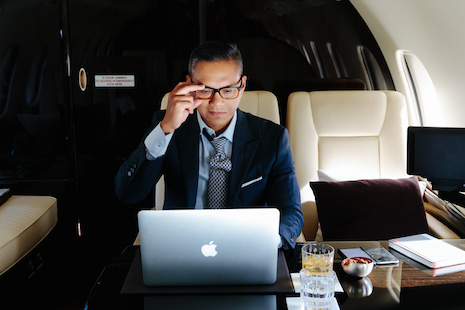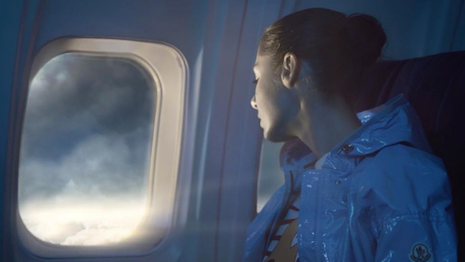NEW YORK – While the cost of private planes used to be prohibitive to all but the wealthiest, newer, more affordable air travel options are enabling a wider population of the ultra-affluent to take advantage of private aviation.
New research from Wealth-X and VistaJet presented on March 27 revealed that private fliers are not tied to a single mode of air travel, with even jet owners frequently opting for charters or first class commercial tickets depending on their immediate needs. Flying private is growing at a rate faster than the population of UHNW individuals and the number of privately owned planes, pointing to an increased use of alternatives to ownership.
"The purchase of time is going to continue, very much like the purchase of experience within the luxury sector," said Winston Chesterfield, director of Wealth-X custom research.
"That blending together of experiences and ownership, that stand alone lifestyle, is crucial today because it means that ownership isn’t necessarily the be all end all for this type of experience," he said.
"Given the fact that younger people are moving away from ownership, towards this idea of renting and not buying lots of things...we think that is going to affect this sector as well."
Wealth-X and VistaJet’s "The Jet Traveler Report: The Global Perspective on Who Flies Privately and How" was based on Wealth-X's database of UHNW individuals, which it defines as those with net worths of at least $30 million. Experts and gatekeepers were also interviewed to find out why these travelers are flying privately.
In the air
Owners of private jets and members of private flying programs are typically wealthier than the general UHNW population. Those who have their own plane have an average net worth of $1.5 billion and members are worth $1.16 billion, whereas other ultra-affluent have an average net worth of $670 million.
This differentiation is likely due to the costs associated with maintaining an aircraft or the membership fees.
Private jet owners also skew older, with the majority over the age of 60. They tend to be male and married, with wealth that was self-made.
About one in five jet owners and members work in financial or banking. The report attributes this correlation to the liquidity of these individuals’ assets, which allows them more financial flexibility to invest in private flying compared to those who have their wealth tied up in a business.

Private jet owners and members tend to be older and male. Image courtesy of VistaJet, photo by Alex Cretey Systermans
Tech titans make up 6 percent of private aviation program members. Skewing younger, these individuals reflect the up-and-coming generations’ growing preference for renting over owning.
In comparison to the overall UHNW population, private jet owners and members show greater propensities towards philanthropy, sports and art.
The United States accounts for a significant portion of all privately owned jets. Of the approximately 17,000 jets registered around the globe, about 13,400 are in North America, the region that boasts the most UHNW individuals, with 81,700.
In comparison, Europe’s 64,000 ultra-affluent own under 3,000 jets, while the 63,000 UHNW individuals in Asia have less than 1,200.
While they may not own a jet or a membership card for a private aviation service, the general population of UHNW individuals do take advantage of on-demand charters.
When the ultra-affluent have to fly, they now have a range of options at their disposal, including commercial flights in first or business class.
Those who have the means to choose seek the mode of transportation that will be the most time-efficient. They also weigh considerations about the perceived safety, risks and value of a particular choice.
For instance, UHNW individuals may choose to charter a jet at a smaller airport if they wish to avoid the possibility of terror attacks at a bigger hub.

How UHNW consumers fly depends on a number of factors. Image credit: Moncler
A private plane owner who has a recognizable aircraft might choose to charter if he wishes to remain anonymous.
Private travel also offers more control than commercial flying, allowing fliers to pick their desired schedule. They may additionally opt for their own plane to have a more direct flight between two smaller airports, rather than having to transfer.
Beyond logistics, on-board private plane experiences can be customized to the traveler’s tastes. While consumers from some markets still desire opulent dining while in the air, the majority would rather skip the Champagne and caviar in favor of meals catered to their particular diet.
Getting on board
In an effort to reach tech-savvy luxury consumers, many private aviation companies have launched applications and digital tools to help ease the booking process.
For instance, private aviation marketplace JetSmarter is making air travel resemble ridesharing with a new feature on its mobile application.
Similarly to how services such as Uber allow riders to go in together on a journey to lower costs, JetSmarter is opening up its chartered flights for sharing. SharedCharter builds off the community atmosphere of the JetSmarter platform, enabling travelers to be reimbursed by others who are going the same way (see story).
Similarly, VistaJet expanded its China market coverage with a new Chinese language Web site in support of its recent compatibility with WeChat.
The aviation company is working to capture more of the lucrative business from Chinese luxury travelers as they criss-cross the globe with the launch of its new Chinese site. The move came a few months after VistaJet unveiled the ability for Chinese customers to book a private jet through WeChat (see story).
While these aim to recreate the experience of Uber for flying, for air travel, the human touch is still an important part of the experience.
Panelist Doug Gollan, editor in chief of Private Jet Card Comparisons, noted that luxury travel agencies have grown due to affluent consumers’ desires for high-touch service.
"In the next generation, everyone’s becoming much more tech savvy," Mr. Gollan said. "At the same time, you can mow your own lawn or you can pay people to mow your lawn, and these are people who are not mowing their own lawn.
"And to a large degree, especially in the stratosphere that VistaJet is playing in…you’re still dealing with a market where there’s really high-touch service."
{"ct":"bIn\/rATXZcvyshEHwZ0pmdZaV+IzeD9C0mc3M9orGONyK6o4TJhTXIUyhPehvI8fGNAlzzgWEAbjgGcVeJDWVws6FTuo7kk5OV6ri8RzW3mPFNQ1xhU+grj\/OWV3kgp+JnZOenGeqHz055Lo32J4kDiJ3Nfnqeo9xwMcSNdVxzPCinV7u7euxFuAexZEaZrqS+higW9QKKpbnI9wZ2Pc9OOz8BYMCs\/WPYMQmerQhhIXMWmyQqaxfBmOk5+EKC3FWf4veEeCpTpN0DAQBq9jFfl3wEUFLd9vfTQ84iR30CGB3qlDEPVGCxA1k1s\/IWZloPBqnq3hHNsYK4Dx\/uD0CyaRhktXWeec6aed+2U6zZzRzWTq0VC7QGJIplNxS4p6Fcwzv0dH+hxN3A9dlo\/egEzddwmaYYh7CSddT8X1WHRo09JTr7Bx\/nRf1DGHWdOCNK9eKGJB8Y83F+TP4Xbjnj4wUicXO8NpNf6ejtUyBgXoT7WkuQrlqi3VlaxQMCyKK8ggexT1G2WZ0olup+ay6O9TxD2FobU8Rqnbb2Z2wiZRx5ZROzJt9wqfOOHAS27unY9qSbVyxIjy7NmUqwa8D7ajAn+u48wgfYdBgqidPoJP8gvHUfROj2K1yXgVs4fFnhx0PuOdR9IdMA7udQZnYovFEj2Q\/rOUpLBRxs\/swGAJCAJ6enkRNKaM1h+HKDFCDbss9SZemU05V2fgWj\/FE3wmQzdjm+\/l4hrE3SmqCr9nWo8Zi1JUa3KgJBEpXDbn9MQn3JH91pKgWTjju3vZeEhrGphmdUtc7wWenzluT18IATOfEwGNHGyUqk5bUgkmB89jUsSS3riB1fi2uQVQMCkmf7NiVujwj5ePXfwAl+hLo0rCP\/9hMozkQ4JfeJUKcVRdgBUDdKxJcJ9or8bHhW\/sBMwLc8iMjYmsuZCIx350s8La3lDaOahiwWinA\/5tmYehyZvrEezCqEV6rHZ5KPsxjDOPOJFBdy5jIaVFEZFkkb68MsFFVR6hq+1FoHG6FALiPRBRnnRuDIlaIJmKZ0I2TaR93pn7CvbqHDQ2TrD31PgAdKr\/K7oWdxBGXwnHYRSmvXYbEdg5a5RU0C3zXgmjjmNzZ5Cdb6VlefobdYFzdvp4kvay5Sm88TUjRoOWx6rcXV\/3tOA7tyU4ix31yu83vJbHwtefejChOBmn6uZ1Fu45EKTG5SbKSnXLyIHbg0HWQEKgfGV5mcyQ8cxkTG5F0eDbBkpsjNRff2EYMveffwJDYUD7n4a0p0tiUqCHd4wKAMKVtNnShhyEChxxbtCIoRhFbMfzaQYFvyAnM7whjefnqfZzI92jhgWd0qSuWGmtOSl8n1SkgcFHw9IK2MN9mYk01O\/L4CfooxJXP4FH9x+va0lnugEW2Wzsz11qH4KxCN+KfY8RTBV123OqcueNUxWsgZa1U0jILS8tqPgHzZYPPIP9KNHxQGoBIl1vKL2qUqROApoUL0ShTLOEF57p16oyoYGXuvCcxConYOHWmNxTb\/IDG0v9zYAu26UW+nvOnKoVGe4sBTUlhReJoCJv05dD3WujzPejso9iJJs2Ce\/Tax5yVb2boBrXaEi7ckjYs1CSIhY66wrAkC8ca4VPqieN7cfLPJYQNEYmtZSLOP2Uo3QBVkdrMMZdXcWJUsXfa5I+zLmalR5KYg+NrFx1foB8Sk+PsW\/o0zF55KoIzAaQT93OdaBDAMNZuIKQM4x5qtxcHaoq1\/X8j7\/wQX5PVm5uk81GliA0T2VaNo5y0zXDf+hDZS41wGpFPxbF2OuYcmUxdxMIXPsmXcHEQEDmnBpjX5kj1aEC7\/Sm9bTURqbUjiJMoipt0S\/6ixWmcSqkA+2aaq80YaAGyXTst92+0tIpn8Dx5SNn93B5bBUwHlZ8gx\/QWW+yCfMe+et821sXwfqyDGBufDX2NlOKNmV1hrSVB7n60R2y+r83R5VU5DQ6Al03YDhAFMLjuA9st2AZ0M8RbVwwGT23X1CQb\/lBSz5MbMhGaogYl2NE8rlP\/zVMLAfgMReOscqUVE1+LrREyQcdrRFU39n34Z+yyXAXnPaxQFIdiUSDRzIu2CAFbOKNPoLQzIPH2keA1Vs+arAk8FNlk5PnVxk\/F0\/tFgIIVtJEUha1q\/d8iBNv7WW6313e+b\/3urtnfpDxB2YXeJuUkaJHVDXqSxFxwv8MtHvYI\/5Hh1mU8S\/dQfdSAe49cQIEBcT8km2n1LPrmlWt+QtgaySHtPGwVoZcAuaSeyJHymMUztnv8484c29yisvnqByxdlHx54pFhITDfdcCdQXgJ\/NCZOL81t4nR2Z5BRe21FsIKP1JiWBN8egwCyjJcV4mGnhTLFNMwryjokKzEKqPZMo++9KuPEY8N1iD\/iSYfscmau77XKalFjeARTSDlb\/uDwt8Vnt0hOIPkc\/y9sL7Kf5Ez\/dqEi3c2o9daIef51ez1iFuQzhqueoaYNm5R4SelpeT1yfYIVSgcrEAeZ6BurMjtzWqarBKxmco6ITUmTCiHZrkrNZmtOsY3d\/kLak4coudOiBUZ0ZAU9ZiLZlWr2sIBTGjTP\/yhDwaCLW0poapRZcm6dZGb03\/6erh8ChIhlU2+N0r9Ekgnu0M81Bn1OPxYhKORk\/hrurGunRMftiWGp1qHT4Lbm2haRP+OFHynzRRyAsEP4oaAMrBOnQS89GDYUpul6nynaSxPBs2NHqgfOCqzXwR67gSljjU23W6yqLWyMqZ2cU2SPuFVu2CbGlbLVGHKwen87aMPyopFYMg8wvk++7HSSF5OzR3lm+yzmFV7lYtpyzyiNEe+gHoSQSqvdUPQL4NwxB2jyPpUkytg2pfzqMstemFh0TLOxJapbrWusV+2uXLebdFfUxKZGPw5A0zH\/XgaT1z4UpSLn8yWXVyojWQ17mtfJTJj70PAsN1zT+3yK9C6kxKZS36yew5xvLGDUFY2Xttf+aWHbF3\/Fek5\/YP2nIvcOdZo9gdltio8IyUUHrz3W3B3O+yGOWg5wuMzwEYrWXIBqbISNQxBf40e9vUNn\/7Z42fK7sBLWBrNaVINuqy5T6fNHXkBFVvKOcK9M6WQgqwC3Hzm\/WOIRWaDLucsRD6yU8h3hazYyMvxYrLwgZERB78Pby08ieI+LvjlYyLKTo38cC8Lc48Pk87JW37XjMcEjGA6cyBVuaiQihfR6Hpr4AKssY+10gnbfjSBvjiuqCAWoHYzNk59E2vb5R4idmy\/fXnAkKPG24KmrjFaxbVzqrqhL2wAxNGmO3XLT7k6ozRti+w1UQTpZERD8WQqYC63LRgUnPNMfPbL1Pk8VUZMwP9SkVEi3m5Nv3SBTWZroeKsnYZfIfO\/Ml6qjWyPU0YUEt04TKsiFCMMhEw7Tw7bdLGKzryLMVRJGXhWUMrdGQTUJ9gglBrYhP4sXdIJma1j0WnNZW271dOGc5ygTomYWLH4T7fzOeTyQ9\/zoAFFMEqDGai2RsC+e8isJZNwYAfYXP4IrOg\/n4SgBZ+njaOcdjxnXRBEmsM44LGC39FHsKDdVSfROlBDZFbDAio3WDGrSlLyBVDaIuPW38vgT5eEw2DHQVgGZ5zdftsuZwL1kz4e8Dxh10oU1jBwcebIOqwI8iQOfDOx2gzGGXf93Bx1V0ohcfTD\/BPQjkuG62McVA7unuCDtF08XCXqgwU0vSyXaeQU+FiAIW9fINgV2g1TZMmmhvgiTQk+jMNiL4wiwrOUakrVbQEAwMhwu7tsx\/ycvjpfvwVslIAzk8g3EEEhk1xj1rmHtfm1on1O95HBl43BwR1CfNZKtHAk0DWcXUBM8AVQiUp5IhE2rcmch7VGkgDuvXKY5b6uIUT+48QLilv+UHlMO5bnmQMkARFRtsu1woXH\/nyCESFB1XApOCwaV49qUMHf6nTaFBuJ\/qCCip2h4eBjoARu9g9hZC\/FEYHZNLSCeJF0Op9Q9hz5vAY4ugKfs8pBJpgGsoBCiKA0Ev\/qNGfA616wMLVBvt1xEnwr+oEBuP1qUNx4mkB1VcOaUqb3GHqIU5nPggb2kaK7HDMG3qAu8fjjOgW9z\/LTHgiTuLYlD25ncPNiFCU5DdaVjixjUfnn9idBQjp+lVPABl3ewmTYt12kOH9+NNNPEeYStKqDUfR281TxLNK0uBN2lM7y1zSO08m5dHWVF\/ntE5RtBwEZu9rze0wTPKqu4so5YZFL4WP0IVz221ERXXRqMJ5VZNdUIYD0QWfp2cvgH3DhQIvuN9R3iAW2+99ZvXoSr3M6pJMMhN5CKdWYvt59jcquW7ONdRs2HJztSFMO9ZUD2sHRMht9u\/RDLWPF72IF9NBxZyJBRCYM9gIhNDyWE7+qGJK1830jFkWUEtoh2qcJIe6ZAvFt4UZipVk4dgLhYz+4eUEpW4PHb\/51uQ\/4lKUgBS3kM7hrS2IgKh\/RV6YH\/KktfYuTwKXzM2gfsbsGdregu1qeUY3FaRXIqFu0Q0irJ6vhRRjbgNM08B0L0nyJ+CL5ZIZhn0Iknfo699z5MxtbHEzO79TI+UPPxOsC6AtECOktcztkSK5+ynyUsGNeMTwSNWa5DdWd9vMj4DiNVGxC4oKljofD5lsEthBxJvvUhvGyCM00Qo7rn0R\/BSlEfy4zy\/1Vo7XF+pxOgKZbAkFxirF9FoMsHUsxiN7LBCChoGuUFOgMnkhJ5QNPrIvWf9n+bUq7GX1n6DRVH8VOuXX\/aQmT0y\/WEfr3sSgyZA\/RSDdbkANcAca2GcudzFHVJ9v15nW5QY1wLnJb7Nhl4FH6jDPJGg3vH+3m6FKobpYawTqTswXNgKqWcC9grq\/+u\/EvGf\/EAlA\/YvznxSG5z\/6mvltVGDx1v8dO834+ENuicSwnz1t26K6ISPX1o1SbwRawjjuINZxy3amJPgQhkzYgd9U8z9mkJI359eozhQ7TnJuyjHOMqKzv4KJ1hMo06L+uu1IxZ2a0oGxelYaIyydccaf2uZzC+o7Zjs4fiEPV+vR3OYp0rEATHVDsfyu5NGRimVR34teTC\/92BrOB52misvjXKSSKirZdLZ7E0UL0zeGpmGOWoAYb9l\/NikyyHzP31KTEONmo6wPDWqigbtXWH0MdlKIwrqddN8xl8p+J\/eRHwNrs8Noh4rE31Cbv2jUdlllh4QAa2R1NOwZUnDzH0M4rbTfRSd6op37mYRltQU5Cn4+knYTJRSICsTb4pxd8d98\/EjV16hqIlxlQtrdeNjKKRK1MZ3s2HCbyijbRwkQjsPafM+3oMyEGAyOWQvkL9mmZ6C7o19zpes5TKzUeG3aM8nkTVQKHyM7U6cdh+ggz\/mZQ7Wby\/NkL\/84ugUBW+UZWevrRBp3GZUX2DPEMzJPD7kpqSQcw8S9b88qicsE3COt6kChM4+nqOiP6nyvMCqnOsTpD\/NIuxF1Xs+mwnzTdXLbidDeW3TOLf4Wc8M1o4kW87qxQd\/IpHn7XfEXVoH8hMz9MYVZwqeqhsyjy6VH1+0a9\/JhDHcjWdxJ+vzfTMvQY+UZgWNLlsHHbncX0j+LBicMaoG+Fb+t7\/Plr72vUP0wWsrHLbUS4vUnA9tEvSOYbRG+02XscWwx3QCK1AC42cF4U4V+qnXBTKBv11p3yfU8Rvrco3U8LrZgj2QKkOmxb+iSqD\/2doaQDgZ4ScX3LRCX2L1\/pYWL74EMjBfhvMsd9LjPmNePKv7tGvWxTzo7kT2F8lJ7\/F\/ZVvc+LIAcSnmFQD9G\/xTX4WVvsB1atNY1DE2MechvRVAFYlcQ\/dc6X0SRkyVIknyhFGG1TrLjxuthe74Q7sJnI98RzD9y5\/8G9JGooASOvl8uZ+R3lNrQgy38+7cLXGq66TBTVDAIVY5CGs409hAU5Mov5Y0Nmg0Ibq8oEXyZlxy2PVJakt26bWOOxGiM58o1he0QOT83WNmSci8dZKuM8B+xTv9WFobG3X2McbtPdjpZi63iqeZ1BPhbD1a0udsApfePI078yw27Nqodu3dM0rZskcgUkH4eW+T23HTdZ+M8cn6WL2HOfSny+sm82Ehd2z0ji\/b1gCNCVM7pdqU38XvPJqCV6YQYtbDMxFHqNIy90\/rLEmf+cUVYF0I06+4Z1aZKvLzCDUNVjH1XMxKYXPzHteT5joCHv8nnfsZa1+72zIB\/\/CyEBA1QudnX+t+N1\/6hNSif9s+UVEuq8\/bVpmbNWsJIYZ8tXC\/lrYilCWE3hIxFFSIlkgmLv5E+cglSHeb3DJEiBfFNuw0YMdayBlPc89ZvyNt2j0ll3ECwWVTbdt0acYiAHR9AwsH\/qh0\/WA+Ve3T0\/LW0lWmw8tKhVE4Qmx4iUHT2dQxbtIQFCPImCReQ3NLsIc\/VHrqrwZX+h4RAu0TXNg9htoXkbAvH8i6sMKUmaabod32LU\/Uuo6FFRnEIuvI7tBwgmG0ixOHj1QE2SvTk7Q1cqXwOCY\/Wrrxx1287Prrjv3n4+dAfWoJiR+RwxTeXXUufhq6nQwsOxi320jL2G6ZYvqbeh+lQkblrY6w80C7e91Yyz97SV0e4IoJ6vE2sZt3E7v2zWlR8\/1OhfLJR8hHox2hWBLeESfEIKnAELfLl+aTsBSxpzo+bCwzC0Y4Z4\/RXUP\/rTN8CNeJly6HMsonj8qFCtPDP+HfP1vsJUsVS8DSBGpgY\/mx4zHn8gCi5Ge\/cWHiRPQ2RDSj5befd2RmNOA0bcrJaCKyE8DFJEuxANEm9qgdESN4F6FvMdnFUnoMV9R59nbJR1la4lQwixF1wv5svwMR9INMAxoaWfuWwA4E6p7gx6jEK19q\/NabuWtAbte6Q7w8CyZeQG8PV2xguh2ecBIhK0dr6C0wMkXOve9yuLYXlD+7L3UC09BgxrPAnaA\/UzOpNJ0+RCXsSl+jYaLDCzmiSjqedftiqWDEHJHAYD6VcQDs1MqVWn5e+wBJoI7\/Sp8bXpuTpid28NDQBS5xyz2zyLTuJHKF9QQt8OqrdSv0z4VLmfzHAwFPzsTWoCYrr0rM07OKM8PrYmYUz1BGdVJZxsgbYWY1Sufu3wA\/Is2dzLXUEIFy\/YU9kXYfmcJZe2LeQbJ5SFyB\/qbXMd32ls3IGkkhUoPFtLV\/7X+LAY\/5Fe9wtvzcCFcNATMr\/tv\/hthWeZCVjC0Uj0dJX05EAa8I56EKVOYbGfU2+x7j0RIy68gnfg\/aFXisyLAjDNHagWHa7\/UIb2fERFYrsfMPNBuzIy4cPzI0ls9ZYC7z9R89y4PrUORWyKzDm5UXsh7TtmaqZlLrX0f7RWE6CRfAjfvc6WVNIJRxPmGKCh+0mzl++W18MaIhDYoJWhUbNh9hRV\/0ghVgQ1gCyuPL6glsf+i09Hi0yBe1Y0klMiJnN0nhTKPq3fdob7nzR4DEF52hKupgQRbD0EdoBHZjKBul3cXJC0zyXabF2Wm+5jKjedp7B23vmPaEjgDqSiPNUfzL3zz\/gHI7Qexxyr5yy7pvu5i4qoSyytFPlxpg1kfZ1Qgen7PsvoZMVPFIs1bVlxCrMZiVNj8gdLJ7lUb+\/Z\/IslUW69TGg4suPX1ED36y\/rCNljdTO+f3HHL0nY+8WTMT+HrdxAM1eNa48Q3f7xjlSDmeoz8Wr90JeANfOMZLalCidnTngycJDTeW51\/+PfLK3bZTpvxnSGprdjr7DizizOar97Ng+Egw+WZWoQRQC38L0y4QIp6RswFl4b6EwNgvooZXrtPhnO0TlRmXRwuoJ0QWkmSbt0otsvNUQZOXy0pvzIy9+2MFw8wtOfP\/NcfOV7SAySAkD8641f\/aienCZE1C3heimR3ljo2P0TKI2l8YyHF3eyN8LO2h3MWUJ3DK5SJE68waxU5uRhROKP7NubSce4QxuOYD2MX9+Ot4V8bUQ1SckFH8jNO8pUNz1p74QLMh9ZpAqmjYSiKMLVW6GZI7\/xxqedc1mJS+p1h9eDDcf4pN1URg+hf9IVpUyGBWfskmVD6oCceaxozwavoo4UAuvEtPRQiXRrRW7LvSsVbh005lGO4G7y48qTSJINCA3J2UcuJtbeRTJtEldaWwi2ubGtZhV6I41M79\/yAxBen0TDrjSxujDPwBkzfM3BAEV2g2XqrzAy0Lsayg7WKSC5cOJ6sZhUkYikNlAiakyhZB3vzW\/0T1OKpeTSD2yOHeQgmW\/KrAwCXKTtGnKbHizUDuSOEsdaYqkOE5ZpzLWy8DDghqXFBIPd9sX7gg44b\/mdENTZ6BCMD83u2dCqeK4iCbufKIcuYv\/BiECBtOFQB5diqFhLo1S3bymdMmSscu7VC8i701+YYyrybaTDR7CYnfmavyvQAqzfyUTUU7XJzALpm+zSxydyFiRKhEycT6Ziils0KJ5k1VZV5zjlTc1eCJfDXOLdwxIuZNKabw9LBXIogX6SjMWYdRO08eWVByR0VwiqujktmHrp\/+Ojt\/RzpQZTe8S0KH12HGA9g6cvdCnSY+H+HUfcKhcOb7igBpcRZKFZt0US8b6m2RzZTznb8dNPYGTAcgePcc3FbyAwWU9hpUyQ6QNbr5VHz27BJzX8\/ok5pUxzoIHLZvm8ffX689D5sKhvC+JlhlQxf\/fVPfIoVt9Y0UvMTyUdPwKeidegp53wboW+yFTAIkU26M1FA2ldpnZdJOWkQErm4+QhDvEcYerE+zT8IDCsO6yYWDqwHlaze4o5x+QiLXarVqQBa4U3hvHYu5kKQdHmvOc3SwbgRgbJc\/60HVQmq2OmMqwmSf7cr4jvyGWEwmsrkNVA4J1IVdPyHzlf52uVOpA6p\/rLSHM28eOGzyNISUQtpiTC31sP3ZCELckISAJrdyEL1lGACJmVNtE0Dzszva4d74jEpDv1kXTxQAfh8JqNIEznOZ\/P+bjqOwF59+QrL3hi6syvZ\/CaipqtfhOkTd4Eqi5EqGpO9enIneiij7AXtGQdl+ssZf+dmYOs9O9LZLG9fOzJwai7vJZLinfOHW\/EooMCRpsMxF7cYN7AbJU5Ijp1HB47ID85uxwFm8hy5aauI2Ky9iLNq8JcBLoUYvqyX837zKUskmI66kXkomQzsIQHtzU930FKMnql2hb0kujfe1ZagmwVzDdfmvnCSpJrEH433qimktOd42GlpctIz5Gr2uPheqY6KIU8fomsests+\/PeNFcFhow2NdG9q2aFOOQ++9Y5gbDcKgIfQMzl11qcL1I1pdJlNQ5Bk\/U7An0SeF2+OMDGayO2Ekd2LNZWiEkLTMQVyh4fsHuJmrLqeqOW2IOYun6+t1ICmxj\/pJBLmus8xn47A7oeueomYLYVHsnSvW94m5XygbJOw6KTcAlTe2TFIThdS5\/LOzbhPYpS5rLVzWuFhztZU66LEVVrmZWq\/MpMGqB42LolRvfqAmm7F8Nh9mGODR6FUCF7Vk\/Va80OnivVG0A8dX4HuvtfGstDZRWs0jMtFfn04hqCJsQ2YPZrC8SkVx6Zp+FAUmPdW0PwWh3G77lPInR4phn\/JDBnOkTgslc+8APXYlUWuoUti0uJRPQocvBsvC8Q+UjuZ2slsDZgfWsGanHMxO07FkBnaqmEC1AcQLIXHFZxDEzBmyVuDFi3gvtfro3LA\/Vg32kA3Q0Z2aM2Z9WQBB1WTw8r0XSuqSY4VDAwu2nkW60rW1zAFh8fOvjwYETMCdPB46qr6lU6S1UPCfnEAHRmVM+Ybdg3Ng4kydHFQc8yPO1wnYbk7wPdrpAkFPaH1F39vZZ+TnTnC\/P9lz69I95RFdH+KWTRokL1ZeMFJ8URvmcLr6dIu+Gf661SiPAOfwdkUzzn+qTAZ45zvsvJxLe7eBhpo5PnfJvD3m+c8A+SGGyvJpqauBkQitsJ1AJihd9hxclE6CHBV4m5sOLpcRc829JIc2fTc+U3FtQQx23k5Fx7qptnMR7O+fVRyprFF5NWsCi8b2eboXiZdB2ei+sy6oBNj15vu8z56Q0K5qYiNSMXTlNcGtSImksDhDEkkVEjVnjDhw7aVusQZFjqv\/pb9xvhXCynfXhsjkVjUvPwYkC8hrlBtoF378KF+UYQQda9bY+ynj\/UFbov9ibgetMNMw2pQ8FpO6oTe9EUZYF1QgK5Ojoz1Z4h40OddXfK77tiH1qBAyMQqIyfKtlPr4ydH9Q2vA9jn1BkGMaJXN65yKk9x415Kk56Tbz84D8sE4q3pg5k+nqg6LmWfv7IYtLAiSYQymELIzhPZkI0mHeArRO\/3hGiKTmlzWC9hi7Scuu71RKM8OGAhVlpYZ8Xo2UnduIIOgLsnK+bj68fwaxna9OG8SrgjILBUH6042LlArY6h3GU\/+xfO2cSLdAzukpFwdy9cKy5M3l3Ka49\/pj1QmxB3EsQjRIxqiBE6eYLCkbKtIxuLS1TPB6rqRpIZXL0Pbe\/IdSwXeSBgT4xEP4nc2sgI9Os0aDRaEnSrv2tSIgr3wqWjJ14KxUdPUzVLn2wJqhm9jcBkDSpfjq09yAqB4qhElVhs1cCcGoMyjV1lOKJq+1QvGNAldejo0YhItva93buguqCdEWVj18Py5G3pzihpdv6e+dgw9YbLWPSbXYUAXM4U4UUVQ6GKvkqiJxxGXx6x5qrny6fDl4jbiXcpf0bIMuORBjrG30THfkVojGm9QCD1oSArdARyxIveMl2KEljTdEybba09D6sorQeMEOw6W9Diy2EmDMU8rbewBcYAJ8sYByVft\/+Qvtzt6\/ZFY6+6NLxBLYXEzi\/MtqK7IN0EAGBbBTV\/T5plnzLpH9lWNlt4+wpOy1H7aru\/0FIQbLEEo158+nuxXgPERjJC4ka3l9bWL5hSpPZuzEiREgC0N8NTN\/ThqvLkS5unNic9YfZ0nCkzFcmhyFu\/\/xljDurOmWfxGk2S1avyAgA+TopCHa2XA0mBYAEYQ+tIug1mavsrtOhMnMinc4n9atwEZMPtJq3aRNd9p9aaP4cajIDOxG3Zrz7oasV6o0EuaGqXFyvTVuGHYVeoqU8Ypv5VQuJ6fAn9DG44PifbCWQ2A0AgbUAAoaEfFO2vbp2C4WnorQOuHKM4Aei+BUWAk4imIlF2e7KvZ+E41o3jKLhCY1aQD0nFQ=","iv":"f4199e7930d6e16acea7af9932112b53","s":"2d7264b2b7993d24"}

 Private jet travel has become more accessible to the ultra-affluent. Image credit: Michael Kors
Private jet travel has become more accessible to the ultra-affluent. Image credit: Michael Kors